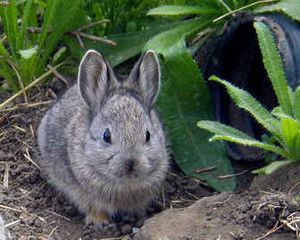Pygmy rabbits get another shot at revival
ENDANGERED SPECIES -- Up to 100 pygmy rabbits—from captive-breeding facilities and from the wild in Oregon—will be released in Washington's Douglas county in the continued effort to reestablish the rare species in Washington.
State Fish and Wildlife Department biologists say the releases will be done in a controlled manner on the agency's Sagebrush Flat Wildlife Area beginning this month.
Read on for details on the diminutive bunny, the effort, and how biologists hope they have learned from past failures to revive the species in the Columbia Basin.
“This is what we call a ‘soft release’,” explained Matt Monda, WDFW’s north central regional wildlife manager in Ephrata.
“The captive-reared rabbits from our partners at Washington State University (WSU), Northwest Trek Wildlife Park, and the Oregon Zoo, will first be kept in a wire mesh enclosure on the wildlife area to help them transition to life in the wild and to protect them from predators,” Monda said.
Keeping the rabbits in enclosures until they become familiar with the site is expected to increase their chance of survival, according to biologists. An earlier effort to release 20 captive-bred pygmy rabbits at Sagebrush Flat Wildlife Area in 2007 was not successful because most fell victim to predators.
Both federal and state authorities have listed the Columbia basin pygmy rabbit as an endangered species. Sixteen of the last-known wild Columbia Basin pygmy rabbits were captured in 2002 and placed in breeding programs at WSU, Northwest Trek, and Oregon Zoo. The captive rabbits were bred to provide rabbits for future releases, but the breeding programs struggled with disease and other limitations of inbreeding from the relatively small founder stock.
U.S. Fish and Wildlife Service (USFWS) wildlife biologist Chris Warren of Spokane said that although the captive breeding program has conserved the genetics of the Columbia Basin population, it may be discontinued due to its limitations and high costs.
Warren said wild rabbits from Oregon are being included in the current reintroduction to increase initial numbers and to breed with captive-reared rabbits. Cross-breeding of Columbia Basin pygmy rabbits with those from other states has been approved by USFWS.
Most neighboring land owners have entered into “Safe Harbor Agreements” with USFWS and WDFW, holding them harmless under the Endangered Species Act (ESA) if rabbits disperse to their property and are accidentally injured or killed during routine land uses. Monda said released rabbits will be closely monitored by project staff.
The Columbia Basin pygmy rabbit (Brachylagus idahoensis) is the country’s smallest native rabbit and the only rabbit to dig its own burrows, which makes it dependent on deep soils in shrub-steppe habitat in eastern Washington. It was listed as a state endangered species in 1993. After the state population dropped to fewer than 40 rabbits in Douglas County by 2001, it was listed as a federal endangered species in 2003.

